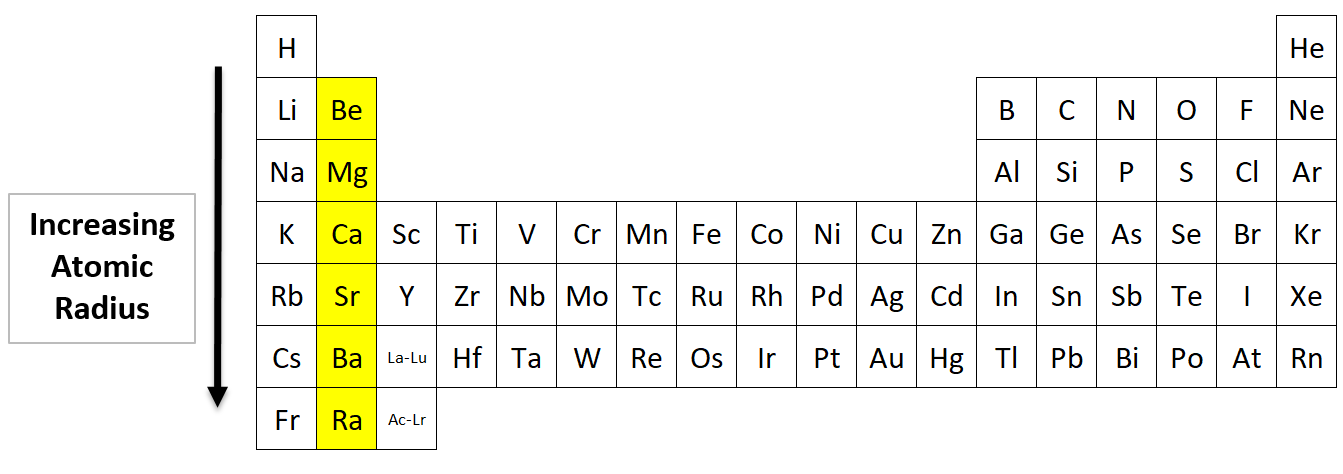
Why does radius increase with higher atomic numbers in a group? As you move down a group in the periodic table, additional layers of electrons are being added, which naturally causes the ionic radius to increase as you move down the periodic table. Is there an increase in the atomic radius across a period A) Generally, the atomic size decreases as we move from left to right in a period of the periodic table. This trend can be explained by considering the energy level and the nuclear charge. Figure 6.32 Within each period, the trend in atomic radius decreases as Z. The variation of the atomic radius in the periodic table follows a fixed pattern. While the atomic radius follows a similar trend, ions may be larger or smaller than neutral atoms. As we go across a period from left to right, we add a proton to the nucleus.But for the nonmetallic elements, the ionic radius increases because there are more electrons than protons. More protons are added, but the outer valence shell remains the same, so the positively charged nucleus draws in the electrons more tightly. Ionic radius decreases moving from left to right across a row or period.This is because each row adds a new electron shell. So attraction between the nucleus and valence shell increases due to which outermost shell is pulled in closer to the nucleus. Atomic radius decreases across a period because the electron is added in the same shell.

As you move down a column or group, the ionic radius increases. The distance from the centre of nucleus to outermost shell of an atom is atomic radius.The size of an element's ionic radius follows a predictable trend on the periodic table.To find the value, ions are treated as if they were hard spheres. In a period, from left to right, with increase in the atomic number, the atomic radius decreases due to increase in the nuclear charge which increases the attraction of the nucleus for the valence electrons. The ionic radius is half the distance between atomic ions in a crystal lattice.While moving down in the group (from top to bottom), the atomic radius increases. Smallest and Largest Atomic Radiusįrancium has the largest atomic size on the periodic table, and helium has the smallest atomic size. Atomic radius trend in Periodic table As we move across the period (from left to right), the atomic radius or atomic size of elements decreases. The Trend on a GraphĪs shown in the graph below, the atomic radius is largest at the first element in each period, and it decreases down each period. As electron cloud sizes increase, so do atomic radii. This is because between each group, electrons occupy successively higher energy levels. Group Trendĭown a group, atomic radii increase. This is why the difference in atomic radii decreases down each period. One thing to note is that the effect of the attraction between the positively charged nucleus and the electrons is slightly countered by the repulsion of electrons as they are successively added. This increased positive charge attracts or pulls, the electrons in closer to the nucleus, decreasing the atomic radius. Atomic radius decreases across a period because valance electrons are being added to the same energy level at the same time the nucleus is increasing in protons.

Down the period, however, the number of protons also increases. This is because while the number of electrons increases down the period, they only add to the same main energy level, and therefore do not expand the electron cloud. Thus, as we move across a given period the ability of the inner electrons to cancel the increasing charge of the nucleus diminishes and the outermost electron. For example, ionization energy, electronegativity, and of course atomic radius which we will discuss now. There are many trends on the periodic table. Let’s break down the trend into its period and group trends. Atoms decrease in size across the period and increase in size down the group. Atomic Radius Trend on the Periodic TableĪtomic radii increase toward the bottom left corner of the periodic table, with Francium having the largest atomic radius. Thus the atomic radius is measured as shown in the diagram below. This is because the borders of orbitals are quite fuzzy, and they also change under different conditions. While your initial thought may have been to measure the distance from the center of an atom’s nucleus to the edge of its electron cloud, this is inaccurate and not feasible.

The atomic radius is measured as half the distance between two nuclei of the same atoms that are bonded together. Let’s discuss the definition of the atomic radius, also called atomic size, and the atomic radius trend on the periodic table.


 0 kommentar(er)
0 kommentar(er)
